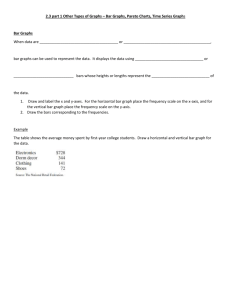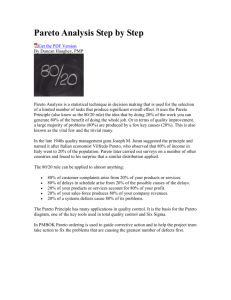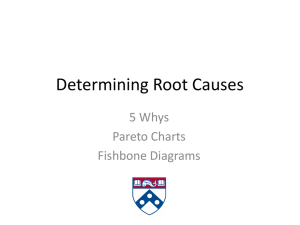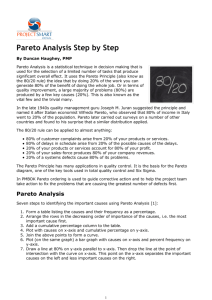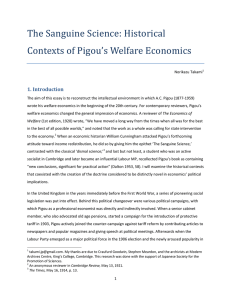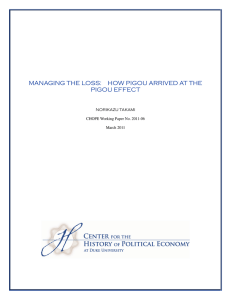Pigou & Pareto on th.. - Post-Keynesian Economics Study Group
advertisement
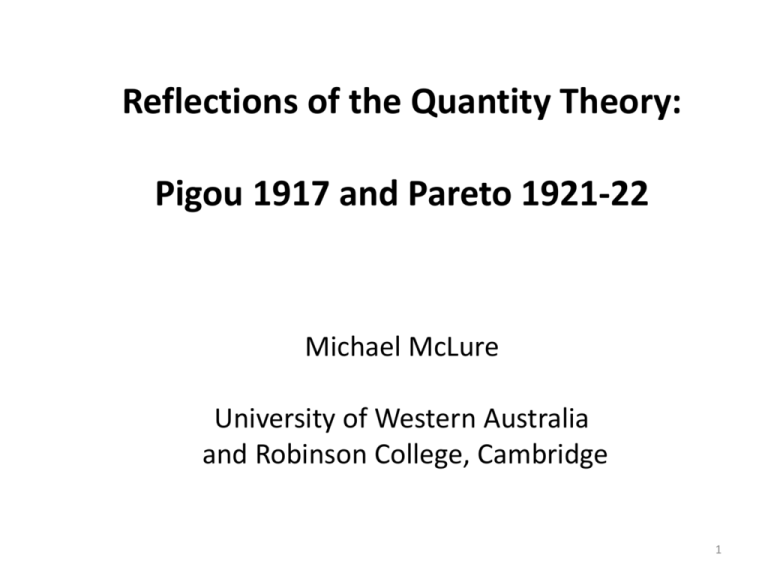
Reflections of the Quantity Theory: Pigou 1917 and Pareto 1921-22 Michael McLure University of Western Australia and Robinson College, Cambridge 1 A.C. Pigou V. Pareto 2 Scope of the Presentation 1) Context 2) Pigou’s formalisation of the Quantity Theory 3) Pareto’s formalisation of the Quantity Theory 4) Pigou & Pareto: concerns with the QT 5) Pigou & Pareto: difference in rhetoric 6) Conclusion 3 1) Context Vilfredo Pareto: • welfare economist; and • Lausanne school A. C. Pigou: • welfare economist; and • Cambridge school 4 Context A) General Welfare • Demand: ophelimity; 3rd parties; and externalities • Difference in scope of economics • Pigou’s first criterion: material dimension. • Pigou’s second criterion: improved distribution • Pigou’s third criterion: reduced fluctuations 5 Context B) Pigou and Pareto’s Law of Income Distribution • Pigou rejected Pareto’s law. • In Pareto’s words, from a mix of induction and deduction we: “… derive two very important theorems. The first of these theorems teaches us that the distribution of income is not due to chance.” 6 The Pareto Distribution of Income Curve N Nt x h h = some low income level above survival for which curve holds 7 Log form of the Pareto Distribution on Income log N slope = - α log x h 8 Context b) Pareto’s Law Back to Pareto’s theorems: “The second tells us that to increase the level of the minimum income or to reduce the inequality of income it is necessary that wealth increase more rapidly than population.” • This is the part that Pigou took greatest issue with. • It challenged the relevance of his second criterion. • But Pigou misread Pareto on this matter. 9 Pigou saw this part of Pareto’s analysis h 0 0 log N log x h h* 10 Pigou did not see this part of Pareto’s analysis h 0 log N 0 Legend: Δnx = increase in taxpayers accruing income of at least x Δnx slope (where ) slope = - α log x h x 11 What Pigou needed to argue was that the Log Distribution Curve has at least one kink log N slope (where ) slope = - α slope (where ) log x h 12 Context Now on to Monetary Issues and topic of this paper • Pigou, 1917, Classic QJE Paper on the “Value of Money. • Pareto, unpublished 1920-21 manuscript “Note critiche di teoria monetaria” [2005, Mornati]. • Pigou & Pareto reflect of the QT 13 2) Pigou’s formalisation of the Quantity Theory. 1) Fisher: MV = PnT 2) Fisher: ; Pigou: 3) %ΔPn = %ΔM ; or %ΔPw ≈ -%ΔM 14 3) Pareto’s formalisation of the Quantity Theory 1) Fisher’s Transactions 2) Money in base year 3) Coefficients: year n to n+1 4) Money in year n+1. 15 Pareto’s formalisation of the Quantity Theory 5) Price change: %ΔPw ≈ (g – π )100 6) Money quantity change: %ΔM ≈ (g + π )100 Conclusion: QT requires ν = 1 (i.e. growth, g, = 0) 16 5) Pigou & Pareto: concerns with the Quantity Theory Pigou’s primary concern is that the share of real cash balances, k, changes. He adjusts k with movements in the proportions of : • customer deposits that banks hold in currency; & • Individual’s cash balances held in banks & currency Causal impact of real activity, R , on k is discussed. R was Pareto’s primary concern: he rejected neutrality. 17 Pigou & Pareto: difference in rhetoric regarding QT Pigou on the quantity theory “At the outset I insist that, tho the machinery that I shall suggest in the following pages is quite different from that elaborated by Professor Irving Fisher in his admirable Purchasing Power of Money, and, as I think, more convenient, I am not in any sense an ‘opponent’ of the ‘quantity theory’ or a hostile critic of Professor Fisher’s lucid analysis.” 18 5) Pigou & Pareto: difference in rhetoric regarding QT Pareto on the quantity theory “One has a theory, complete, simple, beautiful. A shame it does not accord too much with the facts. ... The reality is that there is only a relationship of interdependence and to know the particulars [of the relationship between the quantity of money and prices] considerations other than monetary circulation and prices are needed.” 19 5) Pigou & Pareto: difference in rhetoric regarding QT There are three substantive reasons for the difference 1) QT as a true or false proposition (Pareto) v. a way of organising thoughts to think about money (Pigou). 2) The different treatment of read economic activity, R, in relation to money. 3) Interdependence between real activity and money, in Pareto, finds its explanation in other variables outside economic: sociology of money is not neutral. 20 6) Conclusion Pigou and Pareto would agree that price levels and the quantity of money only move proportionately in highly qualified circumstances. But they separate on the neutrality of money, with Pareto emphasising interdependence between real and monetary; not Pigou. 21 Conclusion This represents a broader difference on the use of equations, and the standards by which you decide to use equations, between Lausanne and Cambridge. • Verify fact v. illustration of a mode of thinking. Curiously though, in this case Cambridge emphasises the equilibrium state, in a monetary world, more than Lausanne. 22 23





